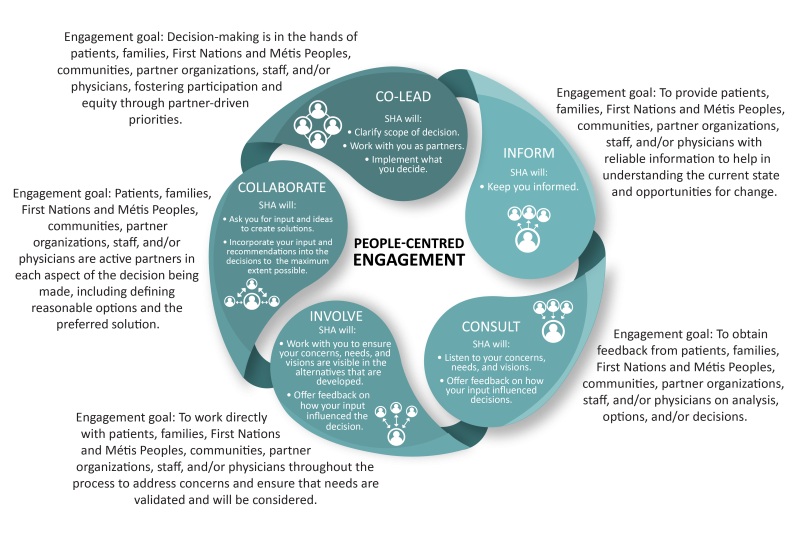SHA Engagement Continuum
The SHA Engagement Continuum has been adapted from materials created by the International Association for Public Participation (IAP2). IAP2 is an international organization dedicated to the advancement of public participation and engagement as foundational practices for better decisions across all organizations and industries. The IAP2 Engagement Spectrum is one of the tools that has been created to support the development of clear goals for public participation/engagement and specific engagement initiatives. The Spectrum outlines different levels of engagement in support of decision making, each with a specific public participation goal and promise to the public.
Effective engagement can occur anywhere across the continuum. All levels of engagement are important and necessary. When deciding on the most appropriate level, carefully consider whether you will be meeting the aims of your proposed engagement and whether you can keep the promises of that level. To ensure the engagement meets the expectations of all participants, clearly identify the relevant level of participation at the beginning, make sure it is understood by all partners, and review it consistently throughout the engagement process.
When deciding on the most appropriate level of engagement, carefully consider whether you will be meeting the aims of your proposed engagement and whether you can keep the promises of that level.
SHA Engagement Continuum Tools
SHA Engagement Continuum
Inform |
Consult |
Involve |
Collaborate |
Co-Lead |
|
Engagement Goal |
To provide patients, families, First Nations and Métis Peoples, communities, partner organizations, staff, and/or physicians with reliable information to help in understanding the current state and opportunities for change. | To obtain feedback from patients, families, First Nations and Métis Peoples, communities, partner organizations, staff, and/or physicians on analysis, options, and/or decisions. | To work directly with patients, families, First Nations and Métis Peoples, communities, partner organizations, staff, and/or physicians throughout the process to address concerns and ensure that needs are validated and will be considered. | Patients, families, First Nations and Métis Peoples, communities, partner organizations, staff, and/or physicians are active partners in each aspect of the decision being made, including defining reasonable options and the preferred solution. | Decision-making is in the hands of patients, families, First Nations and Métis Peoples, communities, partner organizations, staff, and/or physicians, fostering participation and equity through partner-driven priorities. |
Our Promise |
SHA will:
|
SHA will:
|
SHA will:
|
SHA will:
|
SHA will:
|
Engagement Examples
Three scenarios of how engagement could assist leadership and partners to identify effective solutions to hypothetical questions are given below. These examples are not exhaustive, but provide suggestions of how engagement could occur across the levels of the engagement continuum.
Question: How can leadership best support staff wellbeing?
Engagement Level |
Description |
| Inform | Leadership determines wellbeing strategies and staff are given information about these. |
| Consult | Staff are requested to fill in a survey to provide feedback on various wellbeing strategies. Survey results are given to leadership, who then provide feedback through the Daily Rounds, or other media, on how the survey results influenced future decisions on wellbeing policies and practices. |
| Involve | Staff are invited to voice their needs and concerns about wellbeing strategies through various forums, such as focus groups or anonymous submissions. Leadership ensures that these needs and concerns are central to decisions about wellbeing initiatives and provides feedback as to how this is done. |
| Collaborate | Staff are partners in making decisions about wellbeing strategies. They are invited to contribute ideas, solutions, and alternatives and work with leadership through an advisory committee to create wellbeing strategies. Leadership commits to Incorporating staff input and recommendations into the decisions to the maximum extent possible. |
| Co-Lead | Staff are asked to determine a project to improve wellbeing. They partner with leadership to test ideas and leadership commits to implementing the most effective solutions. |
Question: What are the service delivery priorities within Health Networks?
Engagement Level |
Description |
| Inform | Leadership determines which services will be delivered and communities are informed about service availability. |
| Consult | Leadership creates avenues to hear from communities about service priorities, such as Town halls. Leadership ensures that these needs and concerns are central to decisions about service provision and provides feedback via methods suggested by the community. |
| Involve | Community members participate in an event to explore service priorities. Leadership provides feedback about how their input influenced decisions via methods suggested by the community. |
| Collaborate | The community and leadership partner together through a community advisory committee to decide on prioritization of services needed by the community. Leadership listens to and incorporates community input and recommendations into the decisions to the maximum extent possible. Committee members work together to ensure those services are delivered. |
| Co-Lead | The community decides which services are required, according to their needs and goals. SHA leadership facilitates the provision of these services. |
Question: How do we engage with patient-family partners (PFP) and staff to reduce the incidence of falls?
Engagement Level |
Description |
| Inform | SHA shares fall prevention strategies with interested parties. |
| Consult | PFPs and staff are requested to provide feedback on existing fall prevention strategies. Leadership provides information through huddles on how the feedback influenced future decisions on fall prevention. |
| Involve | Staff and PFPs are invited to participate in a learning and sharing event in which fall prevention and potential interventions are discussed amongst participants. The conclusions are considered in decision-making. |
| Collaborate | Leadership invites staff and PFP participation on a QI Falls Prevention Committee. The participants explore and recommend solutions to reduce the incidence of falls. The decision-maker includes the committee recommendations in the final decision as far as possible. |
| Co-Lead | PFPs and staff co-design and co-create a falls preventions program informed by evidence and experience. Leadership listens, learns, and responds by facilitating implementation of the recommendations. |



